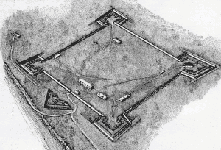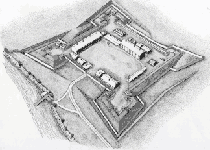History of the fort
Fort Malden National Historic Site
The Fort's Origins

Fort Malden National Historic Site preserves the remnants of the second British fort built in Amherstburg, Ontario. The first, Fort Amherstburg, was established here, near the mouth of the Detroit River in 1796. It was the headquarters for the Right Division of the British Army in Upper Canada during the War of 1812 and was destroyed by the British when they were forced to retreat in September 1813. Today, there are no visible remains of that earlier fortification.
The current dimensions of the fort can be attributed to the American army, which occupied the ruins of Fort Amherstburg from October 1813 until July 1815. The Americans began rebuilding the fort almost immediately, but their efforts were hampered by severe shortages of labour and supplies. Some of the earthworks that can be seen today are remnants of the American occupation.
When the British re-occupied the site in the summer of 1815, they inherited a smaller, semi-completed earthen fortification that contained a few roughly built structures.
The Fort Rebuilt
Until 1820, the British were slow to rebuild the fort as post-war economies forced local commanders to carry out only essential repairs. At Fort Malden this policy meant no new construction until the early 1820s. Between 1820 and 1825, they built several buildings. The fort's Royal Engineer supervised construction of a brick barracks, cook house, guardhouse, artillery shed and several storage buildings. Despite these improvements, very little was done to upgrade the earthworks and the post remained a fort more in name than in actuality.
The reluctance to expend large amounts of money on Fort Malden was partly due to British uncertainty about the future of the site. Through the 1820s various designs were suggested to improve or replace Fort Malden, but with the lessening of tensions between the United States and Britain the fort was allowed to decay and the last British troops were withdrawn in 1836.
Fort Malden Revitalized

The Upper Canadian Rebellion of 1837-38 meant a renaissance for Fort Malden. Troops were rushed back to the fort to repel attacks by rebels and their American sympathizers. Between 1838-40 the fort was almost completely rebuilt. Two large barracks, holding 400 soldiers, were hastily erected as well as an officer's barracks, guardhouse, jail and numerous other buildings. The earthworks were repaired and armed with cannons, and palisades were constructed around the fort.
Despite this revitalization, military authorities pondered the true strategic importance of the fort. The end of the rebellion and improved relations with the Americans meant less need for a large military presence in the Detroit River area. Plans for permanent improvements to the fort were shelved and the last regulars left Fort Malden in 1851.
After the regulars, Enrolled Pensioners (retired soldiers) were brought in to maintain the fort and farm the surrounding the military reserve. No significant construction was undertaken during this period (1851-58) except for the building of cottages to house the pensioners.
The Post-Military Period
It was not until the province of Canada West acquired the fort grounds, and opened the Malden Lunatic Asylum in 1859, that new construction began. Existing structures were renovated to house the patients and staff. New facilities were added, including a two-storey brick laundry. With the closing of the asylum in 1870, the buildings and grounds were used as a lumber yard and planing mill. By the early years of the 20th century, the site had been subdivided and private residences were erected.
In 1921 the Historic Sites and Monuments Board of Canada recognized Fort Malden as being of national historic significance. Through the efforts of local citizens, the federal government acquired land for a small park in 1937. Since that time the park has expanded to its current size, a landmark to those major events which helped to shape the Canadian nation.
Related links
- Date modified :